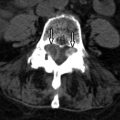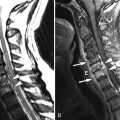Clinical Presentation
The patient is a 67-year-old male with a chief complaint of back pain and a history of prostate cancer. About 1 year ago, he began experiencing occasional chest pain. He would feel a “snapping-like” sensation in his chest. Six months ago he began feeling soreness in his hips and then developed back pain soon thereafter. Four months ago, he was ambulating on his own. Three months ago he was using a cane. Presently, he is wheelchair-bound. He feels the muscles in his back are tight and his legs are weak. He has also noticed some atrophy of his hand musculature.
Imaging Presentation
Sagittal T1-weighted and fat-saturated T2-weighted images of the cervical spine demonstrate several compressed vertebral bodies that display abnormal decreased T1/increased T2 signal intensity. There are also several other vertebral bodies of normal height but with rounded regions of abnormal signal intensity. Several spinous processes are also involved. There is retropulsion of pathologic bone from the T2 vertebral body that impresses the upper thoracic spinal cord ( Fig. 48-1 ) .

Discussion
Multiple myeloma (MM) is a neoplastic proliferation of monoclonal plasma cells within the bone marrow. It is the most common primary bone malignancy, with more than 50,000 active cases in the United States and 16,000 new cases diagnosed annually. The median age at diagnosis is 70 years of age with a slight male predominance. The rate of MM is doubled in the black population as opposed to an age-matched white population. There is an increased risk of MM with exposure to ionizing radiation, farming pesticides, and possibly petrochemicals. There is also an increased risk of MM in people with rheumatoid arthritis or obesity. Patients with monoclonal gammopathy of undetermined significance (MGUS) is found in 2% of people over 50 years of age, and the risk of this becoming MM is 1% each year. Although most MM occurs de novo, it is thought that up to 20% progress from MGUS. MM has a median survival rate of 3 to 5 years with chemotherapy and a 5% rate of complete remission.
In the normal person, plasma cells produce immunoglobulins to fight infection; however, in MM, the plasma cells proliferate and overproduce M protein, which can cause hyperviscosity. There may also be production of kappa and lambda light chain proteins that can cause end-organ damage, especially the kidneys. MM cells also produce cytokines that stimulate osteoclasts and suppress osteoblasts, which can lead to hypercalcemia and the typical lytic bone lesions without sclerosis and osteopenia. MM cells also produce angiogenesis factors that promote new blood vessel formation.
Several staging systems have been developed for MM, the most widely used being those published by Durie and Salmon, dividing MM into three stages depending on overall tumor volume, blood hemoglobin, quantitative Bence-Jones protein, serum calcium levels, and number of bone lesions. Stage 1 has low tumor mass, greater hemoglobin, low Bence-Jones protein, normal serum calcium, and no more than a single bone lesion. Stage 3 has high tumor mass, lower hemoglobin, higher Bence-Jones protein, high serum calcium, and advanced lytic bone lesions. Stage 2 is intermediate between stages 1 and 3. A more recent revision, called the Durie/Salmon Plus staging system , incorporates magnetic resonance imaging (MRI) and positron emission tomography (PET). From less severe to most, there is MGUS that has normal MRI and/or PET imaging, stage 1A (also known as smoldering or indolent ) in which there can be a single plasmacytoma or very limited disease on imaging, stage 1B with less than 5 lesions, stages 2A or 2B (5-20 focal lesions), and stages 3A or 3B (greater than 20 focal lesions). Multiple myeloma is not diagnosed until stage 1B. An A designation is for those with a serum creatinine of less than 2 mg/dl and a B designation is for those above this level.
The initial presentation of patients with MM is unexplained back pain or bone pain. The most commonly affected sites are the vertebrae (66% of cases), ribs (45% of cases), skull (40% of cases), and pelvis (30% of cases). The long bones are also commonly affected; however, distal long bone disease is rare. Pathologic fracture is the manifesting symptom in up to one third of patients. Other presentations include fatigue from anemia, weight loss, paresthesias, and fever. If an older patient has bone or back pain lasting more than 2 to 4 weeks, despite symptomatic treatment, further evaluation is warranted to exclude MM.
Imaging Features
A plain film skeletal survey of the skull, chest, pelvis, humera, and femora is easy to obtain, is of relatively low cost, and can cover a large area of the body. The skeletal survey can detect abnormalities in nearly 80% of patients diagnosed with MM. However, the disadvantage of plain film radiography is sensitivity. Plain films rely on bone loss of 30% to 75% of the cancellous bone to be detected, which can be problematic for early diagnosis. Despite this drawback, most centers believe plain film radiography surveys are the first imaging choice for routine diagnosis and staging of MM. If there has been sufficient bone loss, plain films can demonstrate the osteopenia of MM and/or the well-defined punched-out lytic lesions of MM. The typical lesion is lytic with endosteal scalloping without evidence of marginal sclerosis. Plain films can also demonstrate plasmacytomas, which are often large and expansile, sometimes with septations ( Fig. 48-2 ) . Plain films can also demonstrate the complications of MM such as vertebral fracture.

Computed tomography (CT) is much more sensitive than plain films in detecting small or early lesions as well as fractures; however, a greater amount of ionizing radiation is used and therefore is often used as an adjunct to plain film radiography. CT well demonstrates the lytic lesion(s) of MM without evidence of sclerosis ( Fig. 48-3 ) . CT can also demonstrate extraosseous soft tissue abnormalities, including plasmacytomas, and their relationship to adjacent structures ( Fig. 48-4 ) . In addition, CT demonstrates the relationship of fractured bone to the spinal canal.











